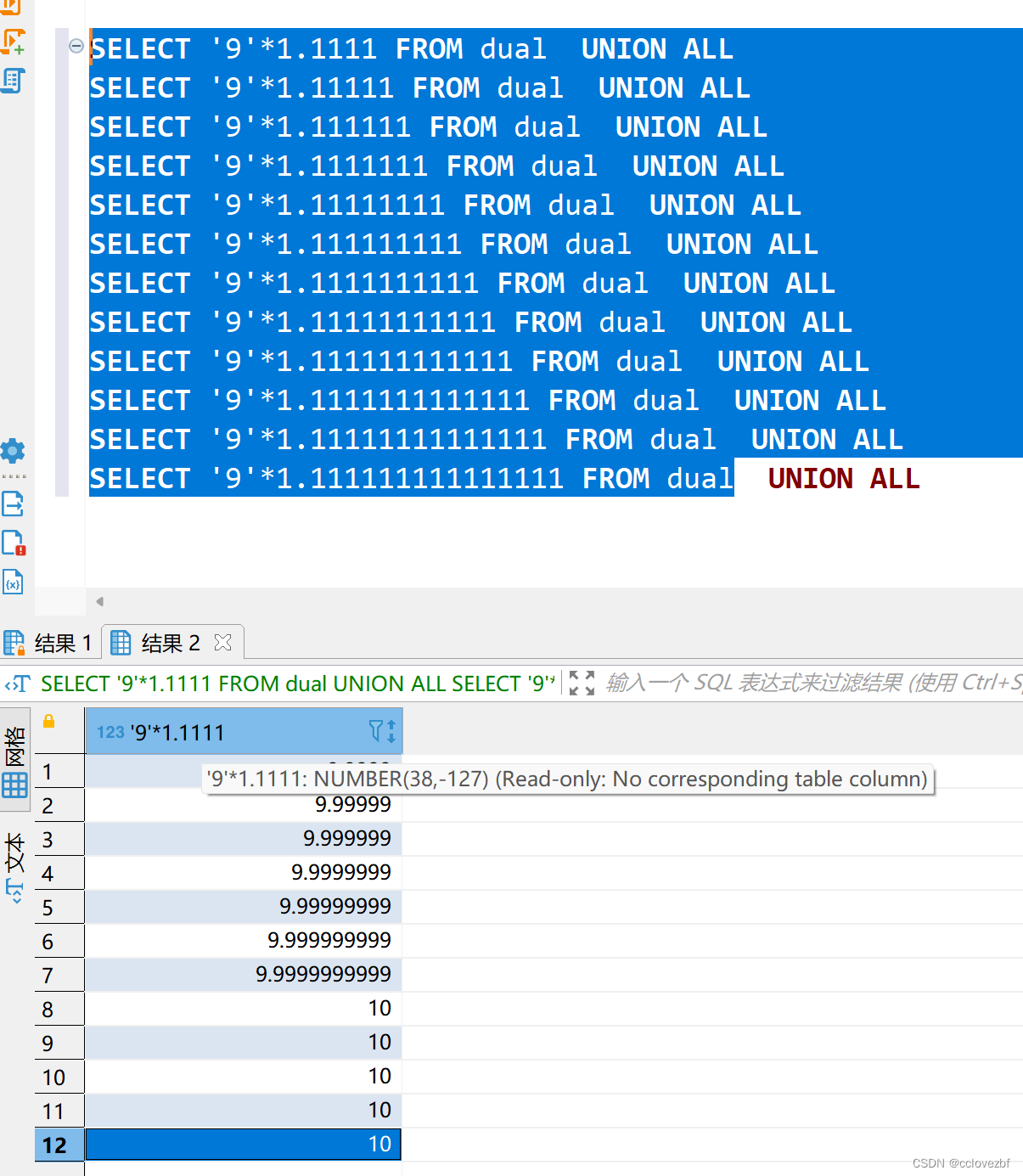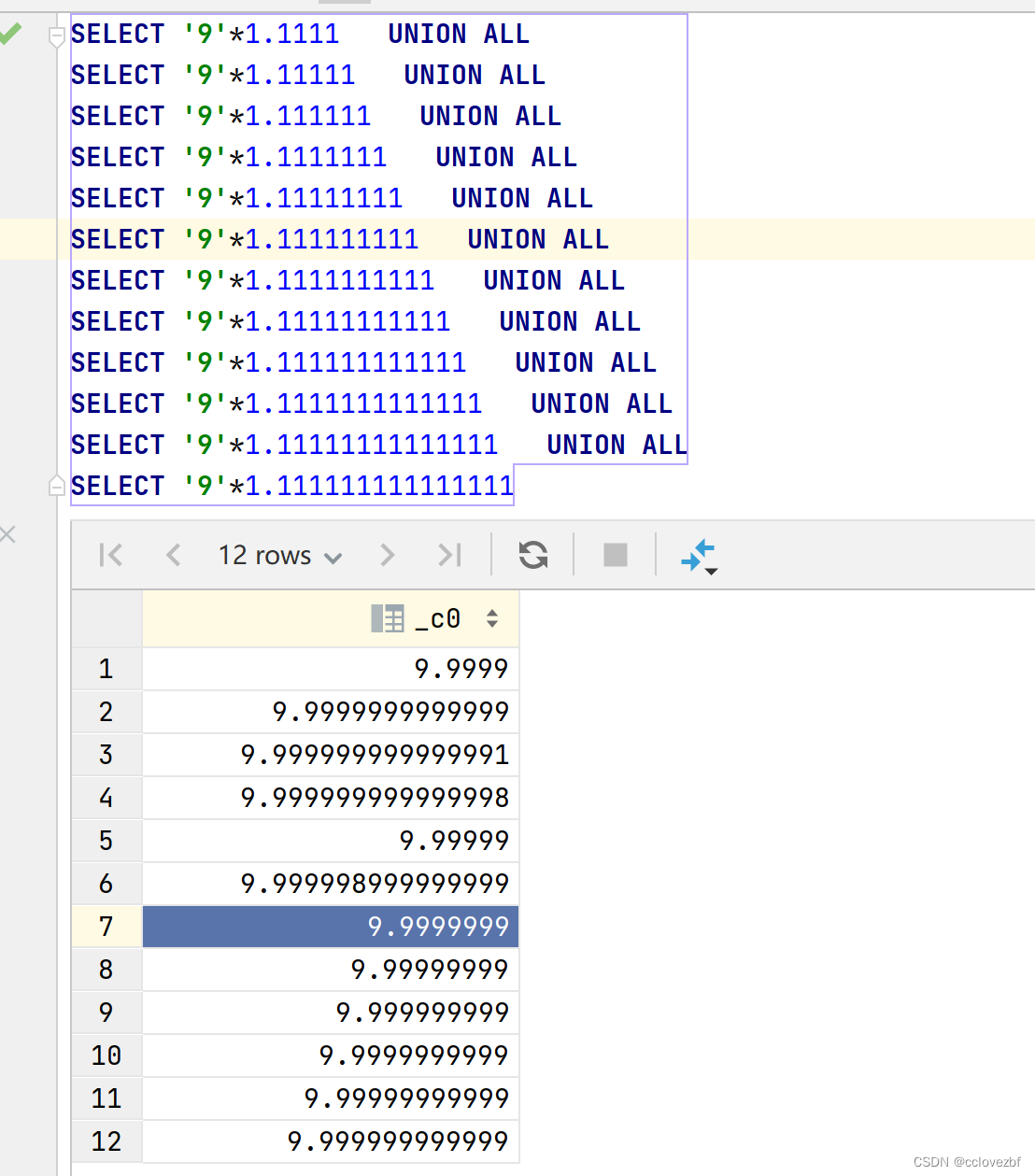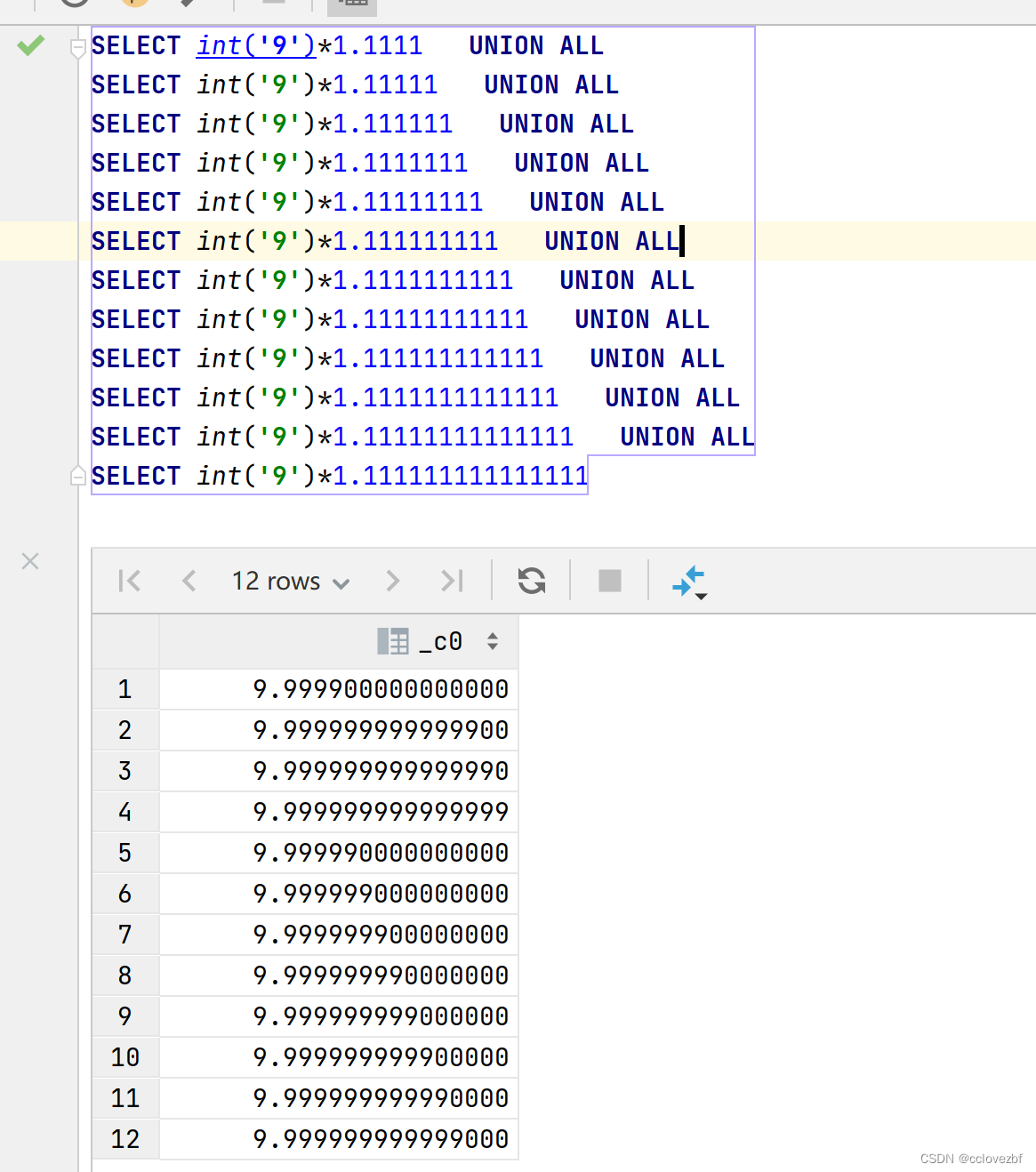比如table id int ,name string
我们可以
select * from table where id='1'
select * from table where name=1
select * from table where name=cast(1 as decimal)
这些都不会报错,因为涉及到了类型的自动转化。
但是 当我们有 nvl(1,'1')时 结果类型时什么样呢? 研究下。
以 +好运算符为例。
打开hive源码 发现两个类
GenericUDFOPPlus
GenericUDFOPNumericPlus
一时间我还分不清我们平常使用 +好运算符是哪个类 找了半天发现是
GenericUDFBaseNumeric
@Override
public ObjectInspector initialize(ObjectInspector[] arguments) throws UDFArgumentException {
if (arguments.length != 2) {
throw new UDFArgumentException(opName + " requires two arguments.");
}
for (int i = 0; i < 2; i++) {
Category category = arguments[i].getCategory();
if (category != Category.PRIMITIVE) { --只能是基础的类型
throw new UDFArgumentTypeException(i, "The "
+ GenericUDFUtils.getOrdinal(i + 1)
+ " argument of " + opName + " is expected to a "
+ Category.PRIMITIVE.toString().toLowerCase() + " type, but "
+ category.toString().toLowerCase() + " is found");
}
}
// During map/reduce tasks, there may not be a valid HiveConf from the SessionState.
// So lookup and save any needed conf information during query compilation in the Hive conf
// (where there should be valid HiveConf from SessionState). Plan serialization will ensure
// we have access to these values in the map/reduce tasks.
if (confLookupNeeded) {
CompatLevel compatLevel = HiveCompat.getCompatLevel(SessionState.get().getConf());
ansiSqlArithmetic = compatLevel.ordinal() > CompatLevel.HIVE_0_12.ordinal();
confLookupNeeded = false;
}
--获取左右两边的值
leftOI = (PrimitiveObjectInspector) arguments[0];
rightOI = (PrimitiveObjectInspector) arguments[1];
--获取结果类型 继续看这个方法
resultOI = PrimitiveObjectInspectorFactory.getPrimitiveWritableObjectInspector(
deriveResultTypeInfo());
converterLeft = ObjectInspectorConverters.getConverter(leftOI, resultOI);
converterRight = ObjectInspectorConverters.getConverter(rightOI, resultOI);
--注意这里 是根据resultOi取将leftOi和rightOi转化为这个类型
return resultOI;
}
deriveResultTypeInfo
private PrimitiveTypeInfo deriveResultTypeInfo() throws UDFArgumentException {
PrimitiveTypeInfo left = (PrimitiveTypeInfo) TypeInfoUtils.getTypeInfoFromObjectInspector(leftOI);--左边是什么类型
PrimitiveTypeInfo right = (PrimitiveTypeInfo) TypeInfoUtils.getTypeInfoFromObjectInspector(rightOI);--右边是什么类型
if (!FunctionRegistry.isNumericType(left) || !FunctionRegistry.isNumericType(right)) { --如果左右两边有个不是number类型就报错
List<TypeInfo> argTypeInfos = new ArrayList<TypeInfo>(2);
argTypeInfos.add(left);
argTypeInfos.add(right);
throw new NoMatchingMethodException(this.getClass(), argTypeInfos, null);
}
--注意这里说了据 如果左右两边有个不准确的类型(str,dou,float) 就是resultOI=double
// If any of the type isn't exact, double is chosen.
if (!FunctionRegistry.isExactNumericType(left) || !FunctionRegistry.isExactNumericType(right)) {
--这个方法是说 如果左右两边有string 我们先转化为double
--如果有个null 我们就返回另外一个类型。也就是double或float(string上一步已经是double)
--如果此时 是float 和double 那就看谁的level高 可以看到float高于double
return deriveResultApproxTypeInfo();
}
--这里就是准确类型相加 一般是int decimal long
--首先看有无null 有null就取另外一遍类型。
--再看类型相等就取同样的类型
--再看类型级别。byte>short>int>long>decimal 。不一样取 高级别
return deriveResultExactTypeInfo();
}
deriveResultApproxTypeInfo
protected PrimitiveTypeInfo deriveResultApproxTypeInfo() { PrimitiveTypeInfo left = (PrimitiveTypeInfo) TypeInfoUtils.getTypeInfoFromObjectInspector(leftOI); PrimitiveTypeInfo right = (PrimitiveTypeInfo) TypeInfoUtils.getTypeInfoFromObjectInspector(rightOI); // string types get converted to double if (PrimitiveObjectInspectorUtils.getPrimitiveGrouping(left.getPrimitiveCategory()) == PrimitiveGrouping.STRING_GROUP) { left = TypeInfoFactory.doubleTypeInfo; } if (PrimitiveObjectInspectorUtils.getPrimitiveGrouping(right.getPrimitiveCategory()) == PrimitiveGrouping.STRING_GROUP) { right = TypeInfoFactory.doubleTypeInfo; } // Use type promotion PrimitiveCategory commonCat = FunctionRegistry.getPrimitiveCommonCategory(left, right); if (commonCat == PrimitiveCategory.DECIMAL) { // Hive 0.12 behavior where double * decimal -> decimal is gone. return TypeInfoFactory.doubleTypeInfo; } else if (commonCat == null) { return TypeInfoFactory.doubleTypeInfo; } else { return left.getPrimitiveCategory() == commonCat ? left : right; } }
deriveResultExactTypeInfo
/** * Default implementation for getting the exact type info for the operator result. It worked for all * but divide operator. * * @return */ protected PrimitiveTypeInfo deriveResultExactTypeInfo() { PrimitiveTypeInfo left = (PrimitiveTypeInfo) TypeInfoUtils.getTypeInfoFromObjectInspector(leftOI); PrimitiveTypeInfo right = (PrimitiveTypeInfo) TypeInfoUtils.getTypeInfoFromObjectInspector(rightOI); // Now we are handling exact types. Base implementation handles type promotion. PrimitiveCategory commonCat = FunctionRegistry.getPrimitiveCommonCategory(left, right); if (commonCat == PrimitiveCategory.DECIMAL) { return deriveResultDecimalTypeInfo(); } else { return left.getPrimitiveCategory() == commonCat ? left : right; } }
deriveResultDecimalTypeInfo
/** * Derive the object inspector instance for the decimal result of the operator. */ protected DecimalTypeInfo deriveResultDecimalTypeInfo() { int prec1 = leftOI.precision(); int prec2 = rightOI.precision(); int scale1 = leftOI.scale(); int scale2 = rightOI.scale(); return deriveResultDecimalTypeInfo(prec1, scale1, prec2, scale2); }
计算精度 可以详见我之前的文章。hive3.1decimal计算详细逻辑_hive decimal_cclovezbf的博客-CSDN博客
public static PrimitiveCategory getPrimitiveCommonCategory(TypeInfo a, TypeInfo b) { if (a.getCategory() != Category.PRIMITIVE || b.getCategory() != Category.PRIMITIVE) { return null; } -- PrimitiveCategory pcA = ((PrimitiveTypeInfo)a).getPrimitiveCategory(); PrimitiveCategory pcB = ((PrimitiveTypeInfo)b).getPrimitiveCategory(); --先看是不是都是基本类型 if (pcA == pcB) { // Same primitive category return pcA; } if (pcA == PrimitiveCategory.VOID) { // Handle NULL, we return the type of pcB return pcB; } if (pcB == PrimitiveCategory.VOID) { // Handle NULL, we return the type of pcA return pcA; } PrimitiveGrouping pgA = PrimitiveObjectInspectorUtils.getPrimitiveGrouping(pcA); PrimitiveGrouping pgB = PrimitiveObjectInspectorUtils.getPrimitiveGrouping(pcB); --看看左右类型是不是同一个组 int/long/decimal/float/doub 都是number组 --string varchar 属于string组 if (pgA == pgB) { // Equal groups, return what we can handle switch (pgA) { case NUMERIC_GROUP: { Integer ai = TypeInfoUtils.numericTypes.get(pcA); Integer bi = TypeInfoUtils.numericTypes.get(pcB); return (ai > bi) ? pcA : pcB; --这里就看level了 } case DATE_GROUP: { Integer ai = TypeInfoUtils.dateTypes.get(pcA); Integer bi = TypeInfoUtils.dateTypes.get(pcB); return (ai > bi) ? pcA : pcB; } case STRING_GROUP: { // handle string types properly return PrimitiveCategory.STRING; } default: break; } }
isNumericType long decimal float double string varchar 都算number类型
public static boolean isNumericType(PrimitiveTypeInfo typeInfo) {
switch (typeInfo.getPrimitiveCategory()) {
case BYTE:
case SHORT:
case INT:
case LONG:
case DECIMAL:
case FLOAT:
case DOUBLE:
case STRING: // String or string equivalent is considered numeric when used in arithmetic operator. -- 这里说了string在 op 运算时可以看做 number
case VARCHAR:
case CHAR:
case VOID: // NULL is considered numeric type for arithmetic operators.
return true;
default:
return false;
}
}
isExactNumericType
/** * Check if a type is exact (not approximate such as float and double). String is considered as * double, thus not exact. * 这里说 float double string 都不准确。前两个精度丢失,string 是不确定。 * @param typeInfo * @return */ public static boolean isExactNumericType(PrimitiveTypeInfo typeInfo) { switch (typeInfo.getPrimitiveCategory()) { case BYTE: case SHORT: case INT: case LONG: case DECIMAL: return true; default: return false; } }
group的概念
case BOOLEAN: return PrimitiveObjectInspectorUtils.PrimitiveGrouping.BOOLEAN_GROUP; case BYTE: case SHORT: case INT: case LONG: case FLOAT: case DOUBLE: case DECIMAL: return PrimitiveObjectInspectorUtils.PrimitiveGrouping.NUMERIC_GROUP; case STRING: case CHAR: case VARCHAR: return PrimitiveObjectInspectorUtils.PrimitiveGrouping.STRING_GROUP; case DATE: case TIMESTAMP: case TIMESTAMPLOCALTZ: return PrimitiveObjectInspectorUtils.PrimitiveGrouping.DATE_GROUP; case INTERVAL_YEAR_MONTH: case INTERVAL_DAY_TIME: return PrimitiveObjectInspectorUtils.PrimitiveGrouping.INTERVAL_GROUP; case BINARY: return PrimitiveObjectInspectorUtils.PrimitiveGrouping.BINARY_GROUP; case VOID: return PrimitiveObjectInspectorUtils.PrimitiveGrouping.VOID_GROUP; default: return PrimitiveObjectInspectorUtils.PrimitiveGrouping.UNKNOWN_GROUP; }
level
registerNumericType(PrimitiveCategory.BYTE, 1); registerNumericType(PrimitiveCategory.SHORT, 2); registerNumericType(PrimitiveCategory.INT, 3); registerNumericType(PrimitiveCategory.LONG, 4); registerNumericType(PrimitiveCategory.DECIMAL, 5); registerNumericType(PrimitiveCategory.FLOAT, 6); registerNumericType(PrimitiveCategory.DOUBLE, 7); registerNumericType(PrimitiveCategory.STRING, 8);
到这里我们总结下。 int long float double decimal string void 。(byte varchar char date暂时不考虑)。
1先看左右两边又没有不准确的类型(float double string void)。
1.1如果哪边有类型属于group_string,那么这个category->category.double
1.2左右两边全都是int double dec,属于精确数字计算
2.再比较左右两边类型
2.1 category_left或者category_right有void,那就返回另外一边类型,不用比较group
2.2 category_left == category_right ,那就返回这个类型,不用比较group
2.3 category_left != category_right 看他们属于哪个group (number_group,string_group)。
再比较左右两边的group
2.3.1group_left == group_right,
2.3.1.1如果是number_group 那么就看谁的level高。(string>double>floatdec>long>int)
2.3.1.2如果是string_group 那么就返回commonCatory(double/float)
2.3.2 group_left != group_right
2.3.2.1此时一般都是 一边是group_number 一边是group_string,那就返回group_string的commonCatory(double float)
2.3.2.2 如果一边为null一边为group_number 返回commonCatory=null
3. 根据左右两边group 和category比较后返回的类型commonCatory
3.1 如果你是1.1 非精确数字计算
3.1.1 最后两个比较后的resultOi=catetoy_decimal 就返回 double(// Hive 0.12 behavior where double * decimal -> decimal is gone.)
3.1.2commonCatory=null 返回 double,
3.1.3commonCatory前两个,那么就看你的返回类型和leftOi是否一样,一样就返回left 否则返回rightOi
3.2 如果你是 精确数字计算
3.2.1 返回结果是 decimla 还需要计算 看第5步
3.2.1返回类型不是dec,那么就看你的返回类型和leftOi是否一样,一样就返回left 否则返回rightOi
4.如果是4.2.1 也就是准确数字计算,resultOi 返回decimal,还需要将leftOi和rigthOi转化一下。然后再运算
好了直接实战。
select str + na, -- double null
str + integ, -- double 2
str + lon, -- double 2
str + doub, -- double 2
str + floa, -- double 2.200000047683716
str + dec1, -- double 2
str + dec2, -- double 2
na + integ, -- integer null
na + lon, -- bigint null
na + doub, -- double null
na + floa, -- float null
na + dec1, -- double null
na + dec2, -- double null
lon + doub, -- double 2
lon + floa, -- float 2.2
lon + dec1, -- decimal(38,17) 2.00000000000000000
lon + dec1, -- decimal(38,17) 2.00000000000000000
doub + floa, -- double 2.200000047683716
doub + dec1, -- double 2
doub + dec2, -- double 2
dec1 + dec2 -- decimal(38.17) 2.00000000000000000
from (
select 1 as integ,
1L as lon,
float(1.2) as floa,
'1' as str,
double(1.0) as doub,
cast(1 as decimal(38, 18)) as dec1,
cast(1 as decimal(10, 5)) as dec2,
null as na
) t
先详细解释下几个
string +na ,string根据 1.1 转化为double ,根据2.1返回double
string + float, string根据1.1转化为double,根据 2.3接着2.3.1.1,此时dou和floa都是number_group,判断level double高,返回double,
这里简单来说,string+任何其他数字 都是double。
na+dec ,走2.1返回decimal 走 3.1非精确计算,走3.1.1返回double
累了。。。反正 第四步decimla转化和后面计算有点累了 不看了。
---------------------------2023-04更新下-----------------------
很多人看到这 可能不知道意味着啥。
首先hive是类型自动转化,所以很多数据都可以互相计算
select 'cc'+1 这个是不会报错的

再者在oracle和mysql里 我不太记得有没有精度丢失了。
比如 select '9'*1.1111111 in mysql or oracle
oracle 这里没有精度丢失最后的结果是number(38,-127)
下面的10 实际上还是9.999999 只不过我也不知道为啥省略了

mysql 有精度丢失 最后的结果类型是double

但是hive 肯定有精度丢失。为啥因为hive默认把'1' 字符串看做一个不精确的数 也就是会看作一个double,所以double乘以int或者dec 还是一个不精确的数

所以同志们啊 在hive里运算的时候不要贪图一时爽快 直接用字符串运算,一时不出问题,但是迟早会出问题
那么我们该怎么办?尽量不用double 和string运算。就不会出问题了吗?

看到这 是不是心都凉了。。。int 乘以 dec怎么也不准确了。说实话 我也没搞太懂,反正各位慎用吧
再看看decimal*decimal 还是有问题。服了。我怀疑是union all的问题 因为我之前在hive的issue里看到好多吐槽union all有bug的



